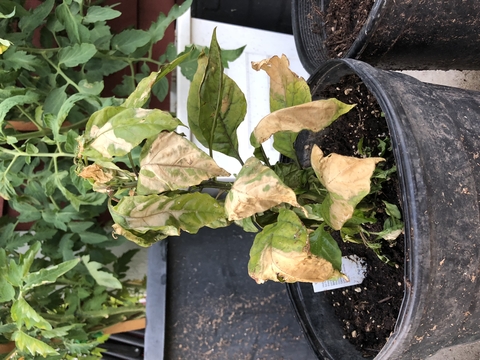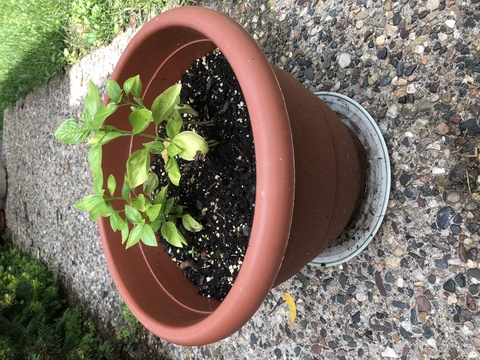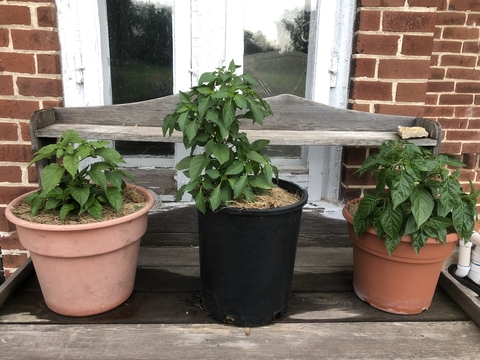Quick facts
- An all-purpose fertilizer is the best option to start with for container plants.
- Follow the label on fertilizers to avoid over-fertilizing plants.
- Depending on the size of the container and the temperature, you may need to water more than once per day to maintain even moisture.
- Mulch helps to minimize water loss from evaporation and moderates soil surface temperature.
- Most container plants prefer moist, not soggy soil.
Container plants are a great way to have lots of green in a small space. They often require a bit more attention than plants growing in a garden, but a little maintenance can go a long way towards healthy, productive container plants.
Fertilize regularly
Even if you used a potting mix with a slow-release fertilizer, repeated watering can leach nutrients over time. It's a good idea to start regular fertilizer applications between two to six weeks after planting a container, depending on the type of potting media, watering schedule, and rate of plant growth.
There are many options for fertilizers to use in container plants. A good place to start is with an all-purpose fertilizer.
- All-purpose fertilizers have nitrogen, potassium and phosphorus, nutrients plants need in large amounts, as well as other essential plant nutrients like iron, manganese and zinc.
- To promote flower or fruit production, select fertilizers with higher amounts of phosphorus or potassium relative to nitrogen, such as tomato food or bloom boosting fertilizer.
Soluble or slow-release fertilizer?
- A soluble fertilizer will easily dissolve in water, allowing plants to access the nutrients right away.
- Soluble fertilizers are easy to use and are a good choice for container plants, where rooting space is at a premium and nutrients are often lost through frequent watering.
- A soluble fertilizer is the best choice for plant health when nutrients are needed quickly, such as when the lower leaves of your tomato plants are turning yellow because they don't have enough nitrogen.
- Slow-release fertilizers can also be used effectively in containers, where watering releases small amounts of nutrients over time.
- Large, fast-growing plants may need more nutrients than slow-release fertilizers can provide, so keep an eye on your plants and supplement if needed.
Regardless of which fertilizer you select, it's important that you follow the label to avoid over-fertilizing, which can damage plants and send excess fertilizer into the environment.
You may want to consider more frequent fertilizer applications at a lower rate to prevent nutrient loss with water drainage. For example, if a fertilizer calls for one scoop per gallon and you fertilize once every two weeks, try using a half-scoop per gallon and fertilize every week instead.
Maintain even moisture
Maintaining even moisture is challenging for container plants.
Depending upon the size and material of the container, you may need to water more than once per day during hot, dry weather. At a minimum, you'll usually need to water at least daily.
Avoid letting your containers dry out for too long. Plants can become quite stressed from prolonged periods without water.
Mulch is good for containers, too
Not only does mulch minimize water loss from evaporation, but it also moderates soil surface temperatures, keeping plant roots a bit cooler in the hot summer sun.
Mulch prevents soil from splashing onto plant leaves during rain or watering. Splash can spread plant pathogens from the soil to plant leaves, which can be particularly problematic for tomatoes.
Just as mulch helps keep weeds from germinating in containers and raised beds, it may moderate desirable plant spread, particularly if you mulch too close to the plants.
Mulch may not be the best fit for all containers, but keep it in mind for maintenance and saving water.
For container plant mulch:
- You can use herbicide-free grass clippings.
- If you don't have access to grass clippings, you can use natural fabric like burlap or even a bit of straw or hay if your containers are large enough.
- Shredded newspapers, coconut coir or other natural materials may also work as mulch.
Watch out for soggy soil
Finally, if you use trays to catch water (and nutrients) under your plants, be sure that the retained water does not cause prolonged periods of waterlogged soil. Most container plants prefer moist, not soggy, soil.
Saturated soil can lead to nitrogen loss from a natural process called denitrification, where bacteria convert a plant-usable form of nitrogen (nitrate) into gaseous forms that move from your soil to the atmosphere.
Be sure to dump your water-catching trays regularly to prevent waterlogged soils and nitrogen loss.
Reviewed in 2024





